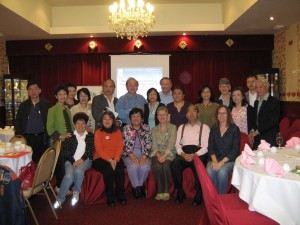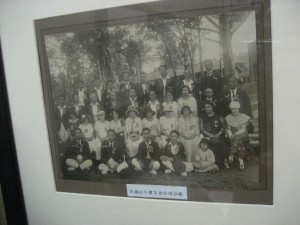In October 1911, the Sydney Morning Herald published a short article under the headline, ‘An indignity: photographs and finger-prints’. The article discussed the situation of Charles Yee Wing, a wealthy and respected Sydney businessman, who had asked to be exempted from having to supply his handprint and photograph as part of the process of being issued a CEDT.
Yee Wing had travelled before and was well-known to Customs officials. In this case, the Customs Department was willing to dispense with the necessity of taking his fingerprints, but Yee Wing was still required to provide his photograph. As the Herald wrote:
Mr Wing is a merchant of some standing, held in high esteem by Europeans and Chinese alike, and it was supposed that in his case the notification would be a purely formal business, and that he would not, since everybody who has business relations with the Chinese community knows him, have to go through the process by which the officials identify on their return Chinese domicilied in Australia who have been for trips to their native land.
Yee Wing’s primary objection was that the officials insisted upon photographing him, in various positions, ‘just like a criminal’.
(This photograph of Charles Yee Wing was taken three years earlier in 1908, when he travelled to Fiji where he had business interests. It was the ‘profile’ photograph attached to his CEDT (Certificate Exempting from Dictation Test). NAA: ST84/1, 1908/301-310.)
Today our images are used to identify us in all sorts of situations—passports, drivers licences, student cards, work ID cards, building swipe cards and even online with sites like Twitter or Facebook. We have varying amounts of control over what images of ourselves are used in these contexts—I know that I have a couple of passports with photographs that I would rather had never seen light of day, and I hope that they aren’t the only images of me that survive for future generations! But we generally accept that these representations of ourselves are necessary. And we certainly don’t think when we head to the post office for a new passport photo that we are being treated ‘like a criminal’. So why did Charles Yee Wing feel that way?
A hundred years ago, few people had formal papers which stated their identity, and the use of photographs on such identity documents was still in its infancy. It wasn’t until World War I, for example, that countries like the United States and Britain developed passports specifically designed with a space for a photograph. But over the second half of the nineteenth-century, authorities had begun to use photographs for administrative purposes, particularly as technologies such as the carte de visite made photographs cheaper and more portable.
In Australia, authorities began using photographs in an ad hoc way to assist in the identification of Chinese entering Australia in the 1890s, perhaps even the 1880s, but by far the most common official use of the photograph at this time was in the photographing of criminals. In New South Wales, for instance, the keeping of gaol photograph description books commenced around 1870. Such mug shots were used by police in identifying and keeping track of criminals and, in fact, the close tie between this form of portrait photography and its criminal subjects led some to criticise its use—because it tainted the practice, and art, of photography more generally.
In 2005, the Public Record Office of Victoria (PROV), together with the Golden Dragon Museum in Bendigo, launched what became a popular travelling exhibition, Forgotten Faces: Chinese and the Law. The exhibition presented large reproductions of gaol photographs of Chinese men imprisoned in Victoria between the 1870s and 1900, accompanied by brief biographical sketches drawn mostly from court and prison records. Dr Sophie Couchman, who knows more about photographs of and by Chinese Australians than any other person alive, was critical of the exhibition for ‘deliberately pulling photographs of Chinese prisoners from the wider prison archive’, thereby presenting the Chinese in colonial Victoria as both criminals and powerless victims of government bureaucracy (Couchman 2009, p. 122). Sophie futher noted that in doing this, the exhibition obscured the fact that Chinese were being treated in the same way as other residents of Victoria. In 2011, the PROV has put a selection of the images from the exhibition in its wiki, encouraging user contributions and plotting the subjects’ place of residence on a Google map.
A wall of faces
As part of our Invisible Australians project, Tim Sherratt has recently been experimenting with facial detection technology to automatically extract and crop photographs from CEDTs. You can read Tim’s discussion of what he’s done over at his blog. After extracting 7,000 photographs from Sydney series ST84/1, about a seventh of which is digitised in RecordSearch, Tim built an interface to display them as an interactive wall of faces. As Tim was putting it all together, I thought of Sophie’s critique of the use of photographs of Chinese people in the Forgotten Faces exhibition and of the way the images had been assembled together in rows as a kind of rogues gallery. I also thought of Charles Yee Wing’s comments a hundred years ago about the indignity of having to provide his photograph for a CEDT.
Could the same kind of criticisms be levelled at our wall of faces as at Forgotten Faces? Are we representing our subjects as more than passive victims of a racist bureaucracy? Are we using their images respectfully and decently? Are their images able to be understood by our contemporary audience? And how should we acknowledge the resistance and opposition of people like Charles Yee Wing?
I have been working with the CEDTs and other associated records (the ‘White Australia records’, for want of a better term) for about 12 years. The photographs are a significant part of what keeps me coming back to them—the photographs and the details about real people that are also found in the records. One of the challenges with writing about the early Chinese community in Australia has been to break through particular stereotypes, and one of the most powerful ways of doing this is through close-grained and detailed studies of individual lives. Yet uncovering those lives can be a difficult and time-consuming enterprise, for they were mostly ‘small lives’ which left only a faint trace scattered across the archive. The White Australia records provide an illumination of those lives, and are now widely used by families to uncover important and unknown information about their forebears.
When I began my research, the CEDTs and case files were not described individually in any catalogue or database, and they were certainly not online; the only ‘finding aids’ were the original handwritten indexes. I used to trek out to the archives, order up box after box after box, and look through the files one by one. In some instances I was the first person to have looked at the records for perhaps decades—the descendants of the men and women whose lives are recorded there knew nothing of the treasures the records held. But putting stuff online and allowing it to be discovered can have really meaningful results.
Since I put my PhD online, for instance, I’ve been contacted by a number of people who cite my research as the catalyst for their own journey of discovery into the families’ Chinese pasts—leading them to the White Australia records, which the National Archives has also done a lot of work on to make them more accessible. As Tim and I would both argue, online technologies and new digital methods really do provide significant and meaningful possibilities in providing access to, and ways of understanding, the lives documented in the White Australia records.
So what of our wall of faces? As Tim has noted, it’s not just an exhibition, it’s a finding aid. To me, this is the key. The wall of faces is another way of seeing into the records and into the lives of the individual men and women, the Australians, who were subject to the indignities of the White Australia Policy. Each image links to a copy of the document it was taken from, which then links to the digitised file in RecordSearch, which then links to other items in the same record series, which then links to other record series created by the same government agency—rich archival context.
But through the Invisible Australians project we also want to provide different links and detail other contexts. For instance, the first experimental version of our wall of faces is based on a small set of records, from Sydney and from the first decade of the 20th century. From this sample, we can see that most of those travelling from Sydney were Chinese men, but there were also non-Chinese and women and family groups. Records from other ports and other decades would produce a different pattern of faces—such as a greater proportion of younger or older people, more women and children, or a different ethnic make-up.
This first effort is certainly not perfect, and we’re already learning from it. We made the decision to leave the images at different sizes, and to widen out the crop so that you can see more than just the person’s face. We hope that this allows for some of the individuality in the images to come through—it’s not so neat perhaps, but maybe it’s also not so prescriptive. As Sophie Couchman has noted, the photographic portraits provided to the authorities by Chinese Australians were far from standardised, and many were studio portraits in which the subjects had a great deal of say in how they were represented. As Sophie has put it, they are ‘not so mug mugshots’. And we want our wall of faces to reflect that.
And now back to Charles Yee Wing
Among the images on our wall are the two portraits of Charles Yee Wing taken before his 1908 trip to Fiji. Those from his 1911 trip, when he made his objections known to both the authorities and the press, aren’t yet digitised. I have done a bit of research into Yee Wing’s family, finding a trove of files about his and his children’s travels over several decades. I don’t think, though, that I had come across this particular CEDT—a typo in the item title means that it doesn’t come up under a keyword search for ‘Yee Wing’. But I did find it browsing through the images in our wall.
Bibliography
- Sophie Couchman, ‘Not so mug mugshots: behind the portraits of series B6443’, Crossings, vol. 9, no .3, 2004, http://www.inasa.org/crossings/9_3/index.php?apply=couchman
- Sophie Couchman, In and out of focus: Chinese and photography in Australia, 1870s–1940s, PhD thesis, La Trobe University, 2009
- Jonathan Finn, ‘Photographing fingerprints: data collection and state surveillance’, Surveillance & Society, vol. 3, no. 1, pp. 21–44
- Martin Lloyd, The Passport: The History of Man’s Most Travelled Document, Sutton Publishing, 2003.
- New Zealand Police Museum, Suspicious Looking: 19th-Century Mug Shots, online exhibition







